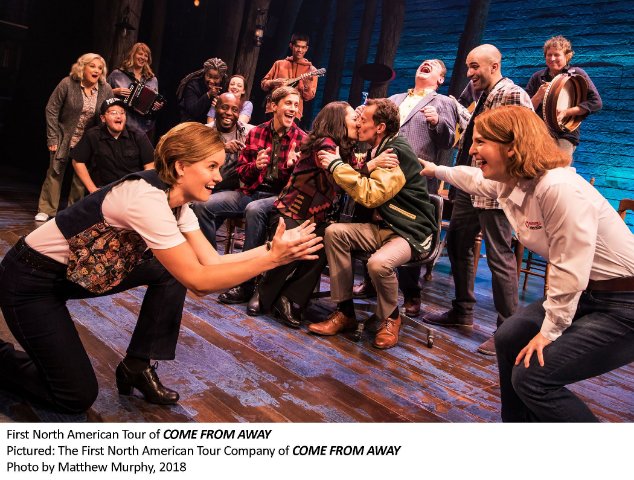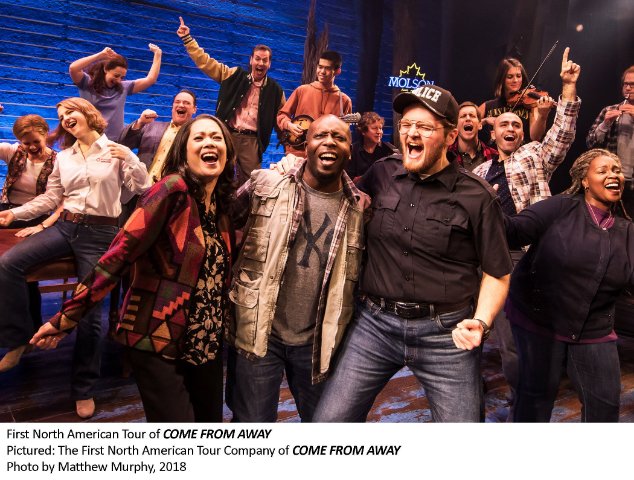Come From Away in Miami
National Equity Tour Of Popular Musical
By: Aaron Krause - Jun 20, 2019
Do yourself a favor: Do not think about Come From Away as just another show “about 9/11.”
To be sure, this remarkable true story would not exist had the terrorist attacks on one of the world’s darkest days not occurred.
But Come From Away, which is hardly depressing, is about so much more than Sept. 11, 2001.
For instance, this award-winning, beloved Broadway musical is about human beings’ innate capacity for kindness and altruism. In addition, the piece, now playing at Miami's Adrienne Arsht Center as part of a strong national equity tour, serves as a welcome reminder. Specifically the show’s creators, Irene Sankoff and David Hein, want to remind us, lest we forget, that even in the darkest times, people with seemingly little to nothing in common can unite to celebrate not only our commonalities, but our differences.
Surely, many of us feel weary. Specifically, we're tired to death from divisiveness, character assassinations, hate-fueled attacks and name calling.
How welcome and healing, then, is Come From Away. It is a true, uplifting, cathartic and funny show highlighting humanity at its best.
Certainly, this musical caresses us like a gentle, expert massage therapist. He/she knows exactly where knots of tension lie and how to relieve them.
As a comparison, the caress feels similar to one we might feel while watching The Band’s Visit. That’s another healing, heart-warming, award-winning Broadway musical. It centers on an Egyptian police band stranded in an Israeli town the musicians mistook for their actual destination. While they’re stuck, the locals befriend them. In particular, the locals ensure their guests -- and new friends -- feel welcome and receive nourishment.
But in Come From Away, the fine folks of Gander, Newfoundland faced a far more formidable challenge.
After the U.S. Government shut down American airspace following 9/11, many airplanes had to land in Canada. And at least at the Gander airport, passengers and crew members initially could not leave their airplanes. Therefore, they received conflicting and confusing information. Why, exactly, did they have to land so far from their destination, they likely wondered. Understandably, the “plane people” as Gander residents called them, were bewildered.
Further, it would be reasonable to assume the following: The locals were hardly equipped or prepared to provide shelter, clothing, food and other necessities to the “plane people” once they could deplane, but were stuck in Gander. Surely, when they woke up on Sept. 11, 2001, the small Canadian town’s citizens didn’t expect 38 planes, holding 6,579 passengers, to land at Gander’s small airport. This doubled the town’s population.
But as Sankoff and Hein gleaned from interviews for their show, people can respond in huge ways when fellow human beings are in need.
For example, in the musical, a local Walmart employee says the following to a stranded traveler: “Thank you for coming to Walmart. Would you like to come back to my house for a shower?”
Meanwhile, the Gander residents managed to feed the nearly 7,000 stranded souls. In addition, they offered them shelter, prayed with them, and sympathized with them. Why, they even proclaimed their guests honorary Newfoundlanders through a lively ceremony.
True, it might all sound like one big singing marathon of “Kumbaya.” But, musical creators Sankoff and Hein obviously wanted to tell a story as honestly and balanced as they could create.
Indeed, at least in Gander, cultures clashed. Impatience and annoyance led to heated arguments. The travelers felt lonely and lost despite the locals’ kindness. Also, people were intolerant, and even cruel. Wisely, Sankoff and Hein included this material. And so, dark material and lighthearted fare, accentuated by appropriate intensities and hues of lighting, combined to form a musical encompassing the wide gamut of human emotions one experiences over a lifetime.
Sankoff and Hein’s diverse score and descriptive lyrics deftly reinforces these feelings and emotions.
The music’s driving, propulsive rhythms lend a sense of liveliness and urgency to the proceedings. These characteristics, especially a sense of urgency, serves the story well. As an example, toward the musical's ending, the travelers are trying desperately to leave. Sure, they cherished their time with their new friends. But they had family and friends on whom they wished to check in the aftermath of 9/11. Moreover, a hurricane was barreling toward the town. And so, airline crews had to rush to beat Mother Nature’s wrath.
While the show’s music conveys a sense of urgency, Come From Away’s creators used music in other ways. For example, a combination of Celtic instruments and other world instruments metaphorically suggests an intersection and embracing of people from around the world. For a Broadway show at least, these non-traditional instruments, including guitars, bodhrans, fiddles and pennywhistles, also help create a flavor of the Newfoundland culture and ambiance, as well as a sense of a welcoming community.
While you might not hum the songs following the show, the music uplifts. Moreover, it moves the plot forward, and evokes several emotions.
Clearly, the ingratiating, lively show-stoppers are “Welcome to the Rock” and “Screech In.” The latter is a playful number during which the locals make their guests honorary Newfoundlanders. “Screech In” is not only catchy, but will likely make you want to get up and dance and clap with the cast.
Speaking of cast members, they perform both numbers with verve and seemingly authentic feeling, accompanied by a robust on-stage band.
Ditto for the more quiet, solemn numbers, such as “Prayer.” During the song, prayers from different faiths blend beautifully. The song touchingly demonstrates how we can live in simple peace and harmony, while practicing our different faith traditions, to paraphrase words from Fiddler on the Roof.
The cast acts as well as sings these songs and more on Beowulf Boritt’s simple set. It consists basically of chairs and tables – and real trees, perhaps to create a sense of authenticity.
The chairs and tables transform into various places. They include the cabin of an airplane and Tim Hortons.
Part of the set rotates, with actors on it. This can suggest that with time passing, the characters change, thanks to their experiences in Gander.
The cast members’ transformations from one character to another by, for example, changing clothes is seamless. Such efforts require teamwork from performers. In particular, they must work together to create the world of the play with few props and set pieces. This notion of helping each other accomplish this can metaphorically suggest a sense of community, like the one the characters inhabit.
Credit director Christopher Ashley for helping the performers find that sense of community. Also, Ashley’s fluid, cinematic-like pacing and inventive staging keeps our interest in the story.
By the way, from all the material that Sankoff and Hein gathered, they faced a huge editing challenge. Remarkably, they managed to tell more than 16,000 stories playing out over the course of five days. Even more jaw-dropping, Sankoff and Hein related these true tales in a 100-minute, intermission-free musical using just 12 actors. Obviously, the authors merged tales to avoid duplication. And the 12 actors portray multiple roles.
These characters’ stories are touching and relatable. For instance, we meet two women. One is American, while the other is a Gander resident. Both have firefighters as family members. One of the American’s loved ones is a New York City firefighter. Her new Canadian friend sympathizes with her as the U.S. woman scrambles to learn news of her loved one’s fate amid the rubble of 9/11.
The Newfoundland dialect, which sounds a bit like an Irish accent, can make it hard to understand every word. Nevertheless, the expressions which register on the performers’ faces clearly communicate their characters’ feelings.
While the actors play multiple roles, there are standouts. They include Becky Gulsvig. She radiates a sense of triumph as Beverly Bass, the first female captain of an American Airlines aircraft. In addition, Gulsvig seems authentically torn as she navigates an inner conflict. Altogether, Gulsvig’s winning portrayal makes the captain someone with whom we can identify and root for.
Meanwhile, Julie Johnson imbues Beulah with an eager-to-please, pleasant demeanor. And James Earl Jones II endows Bob with charisma.
Overall, each actor creates a distinct, convincing character. These are ordinary folks, and Toni-Leslie James’ costumes help reinforce their “everyman” (or “everywoman") quality.
In fact, one might say these are ordinary folks doing extraordinary things.
So again, do yourself a favor. Come on out (from away) to a theater where Come From Away is playing. By the way, it is still on Broadway, as well as on tour.
You won’t hear traditional showtunes. And you won't see, for instance, kicklines or Broadway-style dancing. However, this invigorating and encouraging musical will remind you anew of people’s inherent tendencies toward selflessness.
No question, you’ll long for such qualities to manifest themselves more often during these troubled times.
The national equity touring production of Come From Away might land at your city or one near you. For details about tour stops and ticket prices, visit https://www.broadway.org/tours/details/come-from-away,848



